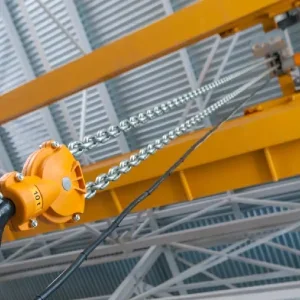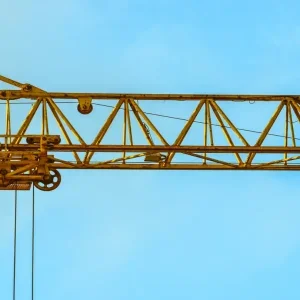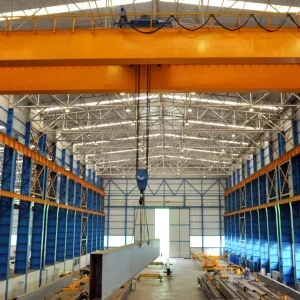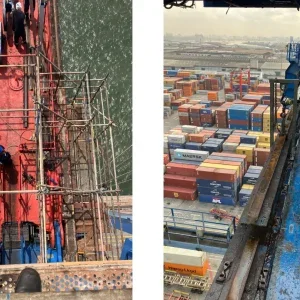Hoist & Winch cut down the existing unit, which weighed 3t and had a 60m lifting height, in sections using gas-burning equipment because many of the hoist parts had seized up and were not easy to dismantle in the conventional way. The company removed the sections to a specially constructed scaffold work platform located below the hoist installation area. Each piece was then lowered to the nearest adjacent floor level 16m below using manual chain blocks, for transportation to the goods lift access located at that level.
To carry out the task of installing the new 10t SWL electric-powered wire-rope hoist, which weighs 2.2t, the company installed a temporary 3t SWL motor trolley-mounted, air-powered chain hoist unit on the monorail beam, raising the new hoist unit the required 60m from the outdoor ground-floor work area, and transporting it into the building over the temporary scaffold work platform.
To facilitate lifting the new wire-rope hoist unit into its final position, Hoist & Winch deployed four 1t SWL manual chain blocks suspended from each end of two specially fabricated lifting frames clipped into position on the top flange of the monorail beam.
The final tasks included electrical commissioning, assembling the hoist on to the monorail beam and the removal of all temporary lifting equipment. Hoist & Winch then performed dynamic load testing of the new wire-rope hoist unit and the monorail beam using a skid-mounted, certified 10t test load prior to issue with a LOLER Thorough Examination report. As part of the dynamic load testing procedure, the outdoor cantilever section of the monorail beam was deflection-tested in accordance with BS2853 using a special, long-range, outdoor-operation Leica laser mounted to an adjustable tripod.
The installation of the new hoist was required ahead of the cement production facility carrying out extensive modification work to its pre-heater tower. The tower is 100m high and the old hoist unit was located at the 60m level on a monorail beam that cantilevers out of the building for approximately 8m.
Both the obsolete hoist unit and monorail beam had been dormant for many years.
“Manufacturing and process plants tend to evolve over time, often compromising general access to existing hoist installations,” said Andy Allen, director of Hoist & Winch. “In other instances, legacy hoists fall into disuse and become obsolete. We’ve seen this on many occasions over the years, but with our in-house design, engineering and manufacturing skills, there is nothing we cannot overcome.”
Hoist & Winch carried out a survey prior to manufacture, ensuring that the complete installation could perform the required tasks with sufficient operating clearance.
The company also submitted its risk assessment and method statement (Rams) for approval by the customer prior to starting work. The documents detailed the installation procedure, the equipment intended for use, and the hazards and risks associated with the various tasks. The documents also set out how it was possible to minimise or negate these risks.






